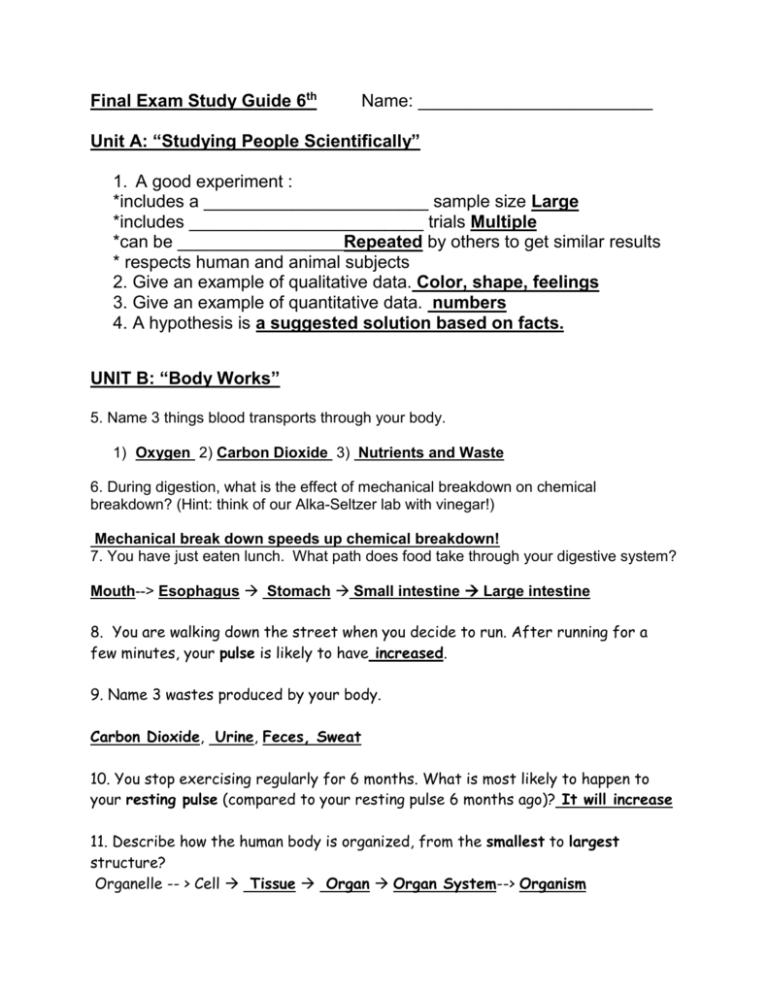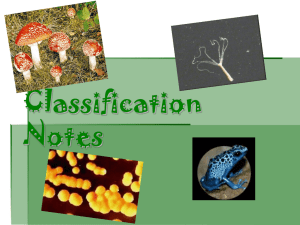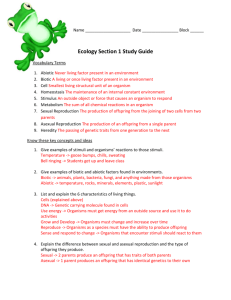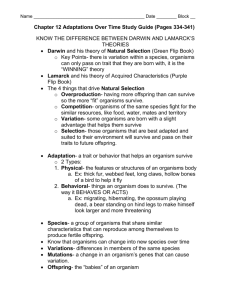24. Antibiotics can be used to kill bacteria and protist.
advertisement

Final Exam Study Guide 6th Name: ________________________ Unit A: “Studying People Scientifically” 1. A good experiment : *includes a _______________________ sample size Large *includes ________________________ trials Multiple *can be _________________Repeated by others to get similar results * respects human and animal subjects 2. Give an example of qualitative data. Color, shape, feelings 3. Give an example of quantitative data. numbers 4. A hypothesis is a suggested solution based on facts. UNIT B: “Body Works” 5. Name 3 things blood transports through your body. 1) Oxygen 2) Carbon Dioxide 3) Nutrients and Waste 6. During digestion, what is the effect of mechanical breakdown on chemical breakdown? (Hint: think of our Alka-Seltzer lab with vinegar!) Mechanical break down speeds up chemical breakdown! 7. You have just eaten lunch. What path does food take through your digestive system? Mouth--> Esophagus Stomach Small intestine Large intestine 8. You are walking down the street when you decide to run. After running for a few minutes, your pulse is likely to have increased. 9. Name 3 wastes produced by your body. Carbon Dioxide, Urine, Feces, Sweat 10. You stop exercising regularly for 6 months. What is most likely to happen to your resting pulse (compared to your resting pulse 6 months ago)? It will increase 11. Describe how the human body is organized, from the smallest to largest structure? Organelle -- > Cell Tissue Organ Organ System--> Organism 12. You have a headache and decide to take some medicine. What would be tradeoff of taking medicine to treat your headache? Side-effects UNIT C: “Micro-Life” 13. Put the following in order from smallest to largest: bacteria, virus, protist Virus, Bacteria, Protist 14. Bacteria can be found where? Everywhere (soil, air, humans) 15. Can an infectious disease be caused by genes? No Can an infectious disease be caused by microbes? Yes 16. Name 3 functions (jobs) a cell performs. 1. Respire (energy) 2. Take in nutrients 3. Waste products (reproduce) 17. Name a disease that is not infectious. Asthma, diabetes, Pellegra, Cancer 18. Name two rules for handling a microscope correctly. 1. Carry it with 2 hands 2. Do not let the objective lens touch the slide. 19. Quarantine is sometimes used to prevent the spread of an infectious disease. Name a trade-off associated with quarantine loss of freedom. 20. Describe the “Germ Theory of Disease.” Infectious diseases are caused by microbes! 21. Substances pass in and out of a cell through the cell membrane. 22. Mark each T (true) or F (false). a. All cells look the same. False b. All cells perform the same function. False c. The shape and structure of a cell is related to its function. True 23. One of the most effective ways you can prevent the spread of infectious disease is to wash your hands. 24. Antibiotics can be used to kill bacteria and protist. 25. What happened to the number of people infected with this disease over time in the above graph? The number increased. UNIT D: “Our Genes” 26. The father of Genetics is Gregor Mendel. 27. Where are genes located? DNA GENES Chromosomes Nucleus Cell 28. The gene that always shows itself is called Dominant. ** Albinism (albino) is a recessive trait. Both parents are heterozygous (Aa) for the trait. If you are heterozygous (Aa), you will not show the trait. 29. How many offsprings are dominant? 3 30. How many offspring are recessive? 1 31. What are the chances the offspring will be albino? 25%, 1:3, 1/4 32. Offspring of sexual reproduction will look never identical to the parents. 33. Traits can be determined by genes or by the environment. 34. Offspring of asexual reproduction get all of their genetic material from one parent. 35. Name 3 organisms that reproduce asexually. Bacteria, yeast, hydra 36. Name 3 organisms that reproduce sexually. Dogs, trees, humans 37. Offspring of sexual reproduction get 1/2 of their genetic material from each parents. 38. Name 2 trade-offs in choosing to have genetic testing. Insurance problems, Costs- $, Find out you have the disease Individuals with the trait are shown with shading 39. By studying the diagram above, you will see the trait skips a generation. You can conclude that the trait is recessive. 40. The gene that gets overwhelmed by another gene is called recessive. UNIT E: “ECOLOGY” 41. You watch a worm slowly disappear into the ground. Give an example of an Observation: The worm disappeared into the ground. Inference: The worm was scared and that is why he disappeared into the ground. 42. List 3 factors that could affect carrying capacity. 1. Food 2. Water 3. Shelter 43. What is the job of a decomposer? Break down dead and waste material. 44. Helen decides to release her pet fish into Lake Mead. What would be the possible trade-offs of her decision? She will introduce a new species into the ecosystem and maybe change the food web and the ecosystem. 45. Fill in the missing information from the photosynthesis formula. Carbon dioxide + Water Sunlight glucose (sugar) + Oxygen A new species of fox has been introduced into Yosemite National Park. This fox eats rabbits that live in the forest. 46. What do you predict will happen to the population of rabbits in Yosemite National Park? It will decrease. 47. The new species of fox in Yosemite National Park added another consumer to the forest. 48. Define “population.” A group of the same organism living in a certain place. 49. Every organism requires a certain amount of water, oxygen, and food. Together, these requirements of an organism and its environments define its ecosystem. 50. In a food web, the arrows show the transfer of energy from one organism to another. 51. You decide you no longer want your pet snake. The best thing to do with it is give it away or return it to the store. 52. What are some of the specific requirements needed by most organisms in order to survive? 1. Food 2. Water 3. Shelter 53. The role of producers in an ecosystem is to convert sunlight energy into food. 54. In this diagram, which of the following is a consumer? Owl, human, rabbit 55. The original source of energy for the food webs is the Sun. 56. Are there any scavengers in the above diagram? No 57. Name 3 things that must be available for a plant to photosynthesize. 1. Carbon dioxide 2. Water 3. Sunlight 58. What is the “niche” or job of a decomposer? The niche of a decomposer is to break down the wastes and remains of other organisms. 59. Give an example of a population. Earth worms living in your garden. UNIT F: “Evolution” 60. “Diversity of species” means that there are many varieties (kinds) of species. 61. What could cause the extinction of a species? 1. Change in the environment 2. Loss of habitat 3. Hunting 4. Lack of food 5. Disease Mark each statement as either TRUE or FALSE. 62. Millions of species of organisms live on Earth. True 63. Organisms have evolved only over the last few hundred years. False 64. Many species that have lived on Earth no longer exist. True 65. Species that are endangered have a high risk of becoming extinct. True Which of these are fossils? 66. Footprint 67. Tooth 68. Bones 69. Rock Yes Yes Yes No ‹— Plants ‹— Fish ‹— Shells 70. What evidence does the diagram above show? A series of rock layers and the presence of fossils. 71. Based on evidence in the diagram above, the organism that lived most recently is the Plants. 72. Name the organism that has survived the longest on our planet. Bacteria 73. What kind of information can you collect from footprints? The organisms foot shape and how many toes it has. 74. List organisms from youngest to oldest. (Fish, bird, bacteria, mammals) Mammals, Bird, Fish, Bacteria 75. Name 3 scientists that contributed to the evolutionary theory. 1. Darwin 2. Lamarck 3. Wallace 76. According to geological evidence, the earth is 4.6 billion years old. A population of birds eats the green moths that live in a pine forest. Every so often, the green moths have a brown offspring. The brown moths are usually seen more quickly by the birds and eaten sooner. 77. The fact that the brown moths are easier to see and are less likely to survive as a result is known as natural selection. Mark each “True” or “False.” 78. The brown moths are probably a result of a mutation. True 79. The brown moths increase the variation within the moth population. True 80. Why do the green moths survive in the forest? They can hide (camouflage) in the forest, blend in. 81. Mutations are always/sometimes/never helpful. 82. Charles Darwin developed his theories based on his work with finches (bird) on the Galapagos Islands. 83. What kinds of evidence did Charles Darwin used to form his theory of evolution? 1. Fossils 2. Finches beaks 3. Skeletons 84. Bringing an extinct species back to life is not yet possible. Still, some people would like to see it happen because the species could be a source of new information. What is a trade-off of such a decision? Change food webs, change habitats, destroy humans (Dinosaurs). 85. Over long periods of time, some species have become extinct, while new species have descended from earlier species. These changes over time are known as evolution. 86. A woman lifts weights and exercises until she is very muscular. She works out with the hope that her children will also be very strong. What is wrong with her thinking? Characteristics acquired after birth cannot be passed to their offspring. 87. Variation is the result of randomly occurring changes over time (evolution, mutations). Mark each “True” or “False.” 88. The more similar the DNA, the less closely related the organisms. False 89. The more similar the DNA, the more closely related the organisms. True 90. The more different the DNA, the more closely related the organisms. False 91. You enter your science classroom and notice some supplies and equipment set up on your table. You should not touch anything until directed by the teacher. 92. Where are we located in the Universe or what is our “address” in the Universe? Universe Milky Way Galaxy Solar System Earth Give 3 descriptions of each of the 5 classes of chordates in the Animal Kingdom. 93. Fish – cold blooded, scales, gills 94. Amphibians – cold blooded, moist smooth skin, lays egg in water 95. Reptiles - cold blooded, scaly (rough skin) , lay eggs on land 96. Birds – warm blooded, feathers, most fly, lay eggs 97. Mammals – warm blooded, hair/fur, live birth (most), milk to young If a new student joins our class, name 3 lab safety rules that we must maintain in our labs to be safe. 98. No Horseplay. 99. Follow directions from the teacher for the lab! 100. Never mix chemicals for the “fun” of it!









